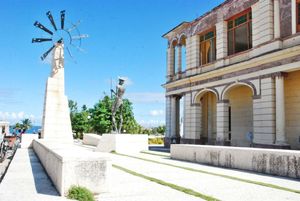

Puerto Padre, Cuba
Go into the historical city of Puerto Padre, surrounded by exotic and idyllic beaches, in Las Tunas, Cuba.
Puerto Padre is a portuary city Northern from Las Tunas, nationally known as ‘Blue Village’ or ‘Mills Blue Village’. It is a place with a long interesting history, since it seems to be the first Cuban port where Christopher Columbus landed. And with this event it is related with of the history which gives the city its name.
The legend goes that in the discovery of America, a sailor, when he sighted the beauty of the waters and the nature opened up before him, said thrilled to a priest: ‘what a port, father!’. However, after several studies it was proved that there was no priest on board of the caravels.
Two hypotheses which are strongly supported are, on the one hand, the possibility of a wreck of a father by the coasts of the bay or another one, more controversial, which comes from the name of San Salvador, the first person who was visited by the Admiral in Cuba.
On the other hand, there is an anecdote which is true about the origin of the title Blue Village, caused by the blue sea waters and the sky of Puerto Padre. So beautiful it is the resource which has been used since then as promotional motto of the city. Later on, the Canary journalist and poet Manuel Martínez de las Casas, added the complementary ‘mills’, by the great amount of them in the area.
Further from this, Puerto Padre is the first free port in Cuba in the Independence War and counts with the Central Antonio Guiteras, the most important raw sugar producer in the country.
Related to its heritage, the municipality has an important valuable collection of aboriginal pieces which denote the material and spiritual culture of this ancestral people. Equally, among the most outstanding monuments in the area, you will find two buildings with special meaning which are currently working as museums: the Salcedo Castle or Loma Fort Museum and the Fernando García Grave de Peralta Municipal Museum.
Furthermore, on your walks through the city you will find interesting sculptures as the ‘Liberty Statue’ located in the Independence Park and opened the 16th October 1904; the ‘Rincón Martiano’, set up in the José Martí Park raised up in January 1937; the sculpture bust dedicated to the mothers in the intersection of the Libertad Av. with the current Máximo Gómez Av. dated on the 12th May 1946; or the sculpture complex of the Quixote founded on the 16th February 1989 and characterized because the Quixote is and sickly downfall figure.
You cannot miss this beautiful city surrounded by virgin and exotic beaches as la Llanita, La Boca and La Herradura, tiny paradises far away from the civilization where you can relax and enjoy white sands and crystalline waters. However, if you want an all-included resort, you can relax in Playa Covarrubias, where you will find the chance of discovering its coral reef of almost 3 kilometers long.
Interactive map:
Las Tunas
What to see:
- Sculptures City
- Monte Cabaniguán Hill
- Puerto Padre
- La Loma Fort
- Plaza Martiana Square
- Plaza de la Revolución Square
- El Cornito
- Ánfora International Magic Festival
Beaches:
Museums:
Other nearby destinations:
Why "Trip Cuba"?
Trip Cuba is an organization of Cuban agencies whose objectives are:
- ✓ To make Cuba, its culture and its heritage known.
- ✓ To promote sustainable tourism.
- ✓ To support the local economy, prioritizing direct contact with Cuban agencies.
Travel Agencies
If you are a travel agency or tour operator and you are looking forward to any assistance or collaboration to plan trips to Cuba, rely on our extensive experience
Copyright www.TripCuba.Org © - All rights reserved
All our agencies are duly registered in the National Registry of Travel Agencies of the Chamber of Commerce of the Republic of Cuba.








